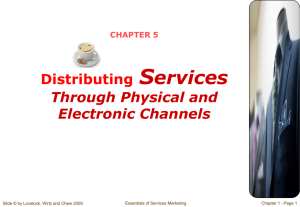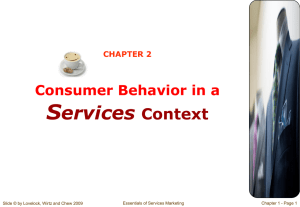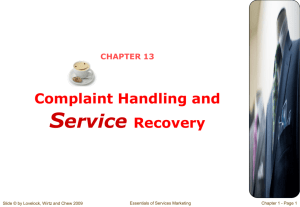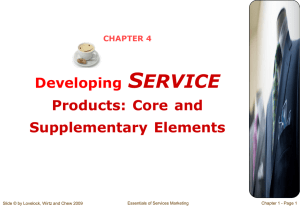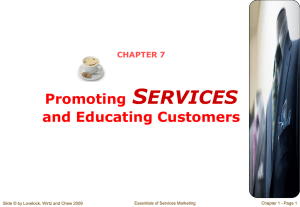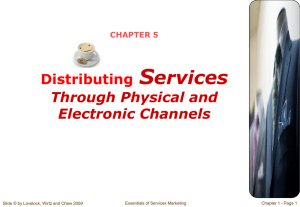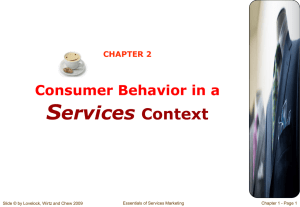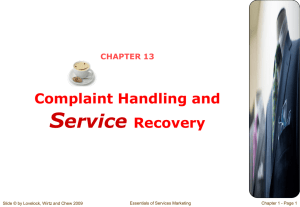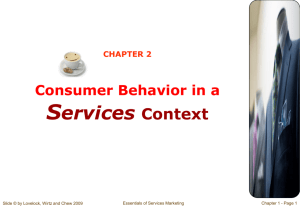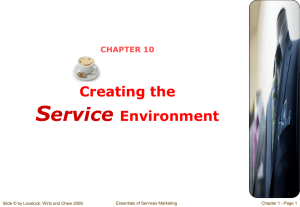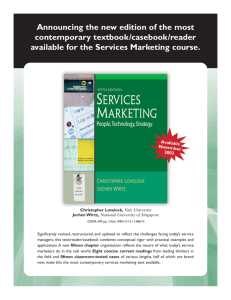Chapter 9
advertisement
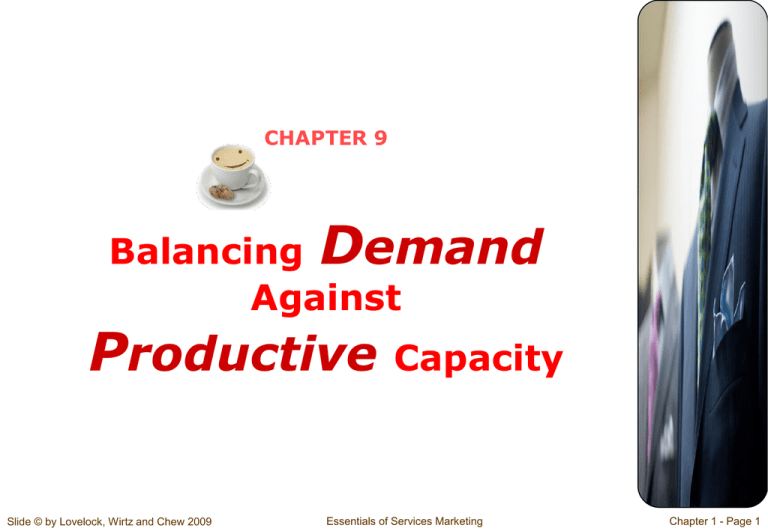
CHAPTER 9 Balancing Demand Against Productive Slide © by Lovelock, Wirtz and Chew 2009 Capacity Essentials of Services Marketing Chapter 1 - Page 1 What is Productive Capacity? Productive capacity can take several forms in services Physical facilities designed to contain customers Physical facilities designed for storing or processing goods Physical equipment used to process people, possessions, or information Labor Infrastructure Financial success in businesses that are limited in capacity depends largely on how capacity is used Slide © by Lovelock, Wirtz and Chew 2009 Essentials of Services Marketing Chapter 1 - Page 2 From Excess Demand to Excess Capacity Four conditions potentially faced by fixed-capacity services: Excess demand Too much demand relative to capacity at a given time Demand exceeds optimum capacity Upper limit to a firm’s ability to meet demand at a given time Optimum capacity Point beyond which service quality declines as more customers are serviced Excess capacity Too much capacity relative to demand at a given time Slide © by Lovelock, Wirtz and Chew 2009 Essentials of Services Marketing Chapter 1 - Page 3 Addressing Problem of Fluctuating Demand Two basic approaches: Adjust level of capacity to meet demand Need to understand productive capacity and how it varies on an incremental basis Manage level of demand Use marketing strategies to smooth out peaks, fill in valleys Many firms use a mix of both approaches Slide © by Lovelock, Wirtz and Chew 2009 Essentials of Services Marketing Chapter 1 - Page 4 Capacity Management Strategies Capacity is fixed, but more people are served at the same level of capacity Stretch and shrink: Offer inferior extra capacity at peaks (e.g. bus/train standees, stretch servers at restaurants) Use facilities for longer/shorter periods (e.g. extended bank hours) Reduce amount of time spent in process by minimizing slack time Slide © by Lovelock, Wirtz and Chew 2009 Essentials of Services Marketing Chapter 1 - Page 5 Adjusting Capacity to Match Demand Schedule downtime during periods of low demand Cross-train employees Use part-time employees Invite customers to perform self-service Ask customers to share Create flexible capacity Rent or share extra facilities and equipment Slide © by Lovelock, Wirtz and Chew 2009 Essentials of Services Marketing Chapter 1 - Page 6 Demand Varies by Market Segment Demand may seem random, but analysis may reveal different predictable demand cycles for different segments Keep good records of transactions to analyze demand patterns Sophisticated software can help to track customer consumption patterns Record weather conditions and other special factors that might influence demand (i.e. competitor actions) Slide © by Lovelock, Wirtz and Chew 2009 Essentials of Services Marketing Chapter 1 - Page 7 Predictable Demand Patterns and Their Underlying Causes (1) Predictable Cycles of Demand Levels day week month year other Slide © by Lovelock, Wirtz and Chew 2009 Underlying Causes of Cyclical Variations employment billing or tax payments/refunds pay days school hours/holidays climate / weather changes public/religious holidays natural cycles Essentials of Services Marketing Chapter 1 - Page 8 Demand Management Strategies Take no action Let customers sort it out Reduce demand Higher prices Communication encouraging use of other time slots Increase demand Lower prices Communication, including promotional incentives Vary product features to increase desirability More convenient delivery times and places Inventory demand by reservation system Inventory demand by formalized queuing Slide © by Lovelock, Wirtz and Chew 2009 Essentials of Services Marketing Chapter 1 - Page 9 When Demand Exceeds Supply: Inventorying Demand Ask customers to wait in line (queue), usually on a first-come first-served basis Offer customers the opportunity to reserve or book capacity in advance Slide © by Lovelock, Wirtz and Chew 2009 Essentials of Services Marketing Chapter 1 - Page 10 Waiting In Line Almost nobody likes to wait An average person may spend up to 30 minutes/day waiting in line—equivalent to 20 months in an 80 year lifetime Not all queues take physical waiting in a single location Queues may be physical but geographically dispersed Some queues are virtual Slide © by Lovelock, Wirtz and Chew 2009 Essentials of Services Marketing Chapter 1 - Page 11 Alternative Queuing Configurations Slide © by Lovelock, Wirtz and Chew 2009 Essentials of Services Marketing Chapter 1 - Page 12 Virtual Waits Customers despise having their time wasted while waiting Virtual queues can eliminate the need to wait Customers register their place in line on a computer / phone, kiosk, etc. System estimates the time customer will need to wait Customers return later to claim their place when alerted by the system Slide © by Lovelock, Wirtz and Chew 2009 Essentials of Services Marketing Chapter 1 - Page 13 Perceptions of Waiting Time 1. Unoccupied time feels longer than occupied time 2. Solo waits feel longer than group waits 3. Physically uncomfortable waits feel longer than comfortable ones 4. Pre- and post-process waits feel longer than inprocess waits 5. Unexplained waits are longer than explained waits Sources: Maister; Davis & Heineke; Jones & Peppiatt Cont. Slide © by Lovelock, Wirtz and Chew 2009 Essentials of Services Marketing Chapter 1 - Page 14 Ten Propositions to Make Waiting More Bearable (2) 6. Unfamiliar waits seem longer than familiar ones 7. Uncertain waits are longer than known, finite waits 8. Unfair waits are longer than fair waits 9. Anxiety makes waits seem longer 10. People will wait longer for more valuable services Sources: Maister; Davis & Heineke; Jones & Peppiatt Slide © by Lovelock, Wirtz and Chew 2009 Essentials of Services Marketing Chapter 1 - Page 15 Benefits of Reservations Controls and smoothes demand Data captured helps organizations Prepare financial projections Plan operations and staffing levels Benefits businesses. Allows management to make sure some time is kept free for emergency jobs Pre-sells service Informs and educates customers in advance of arrival Saves customers from having to wait in line for service (if reservation times are honored) Slide © by Lovelock, Wirtz and Chew 2009 Essentials of Services Marketing Chapter 1 - Page 16 Characteristics of Well-Designed Reservations System Fast and user-friendly for customers and staff Answers customer questions Offers options for self service (e.g. Web) Accommodates preferences (e.g., room with view) Deflects demand from unavailable first choices to alternative times and locations Slide © by Lovelock, Wirtz and Chew 2009 Essentials of Services Marketing Chapter 1 - Page 17
